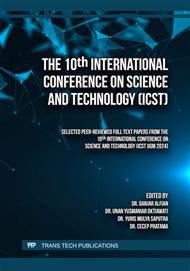p.83
p.93
p.104
p.111
p.122
p.134
p.142
p.153
p.162
Speed Improvement of Maximum Power Point Tracker (MPPT) Based on Perturb and Observe (P&O) Algorithm by Using Fractional Short Circuit Current (FSCC) on the FPGA
Abstract:
Solar panels are a renewable energy source capable of converting sunlight into electricity. The power output from these panels fluctuates with changes in sunlight intensity, affecting the maximum power they can produce. To maintain a stable maximum power output, an automatic controller is essential, and the Maximum Power Point Tracker (MPPT) serves this purpose. The MPPT controller reads voltage, current, and power values from the solar panel to ensure it operates at the Maximum Power Point (MPP). The Perturb and Observe (P&O) algorithm is a reliable MPPT method for stable power tracking, although it has a drawback in terms of speed due to its step-by-step measurement process. In contrast, the Fractional Short Circuit Current (FSCC) algorithm is faster in estimating the MPP value but less accurate in tracking actual power output. Combining the P&O and FSCC algorithms aims to create a method that rapidly determines the MPP value while ensuring stable tracking. The design's implementation uses Verilog Hardware Description Language (HDL) on a Field Programmable Gate Array (FPGA) to create an independent IP-Core MPPT controller, eliminating the need for aprocessor. Implementation results show that the P&O+FSCC algorithm achieves an MPP search speed of about 18 seconds, compared to approximately 55 s for P&O alone, representing a 32.72% improvement.
Info:
Periodical:
Pages:
122-133
Citation:
Online since:
October 2025
Authors:
Keywords:
Price:
Сopyright:
© 2025 Trans Tech Publications Ltd. All Rights Reserved
Share:
Citation:


